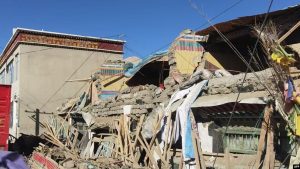
On January 7, 2025, a powerful earthquake shook the Tibet Autonomous Region in southwestern China, resulting in extensive casualties and widespread devastation. With a magnitude of 7.1 according to the U.S. Geological Survey (USGS) and 6.8 as per China’s Earthquake Networks Center, this seismic event had its epicenter in Tingri County near the city of Shigatse, approximately 75 kilometers (50 miles) north of Mount Everest. It caused at least 95 fatalities and 130 injuries, severely impacting the region and its inhabitants.
Widespread Destruction and Casualties
The earthquake caused severe damage to infrastructure, with over 1,000 homes destroyed or damaged, leaving many residents trapped under rubble. The rescue operations have been particularly challenging due to the high-altitude terrain and freezing temperatures, with elevations averaging 4,200 meters (13,800 feet) and temperatures dropping to -18°C (0°F).
In a similar incident on November 22, 2024, a 6.9-magnitude earthquake struck the city of Nyingchi in southeastern Tibet, resulting in identical casualty figures. This quake caused extensive damage to buildings, triggered landslides, and blocked roads, further complicating rescue operations in the already remote and inaccessible region.
Massive Rescue and Relief Efforts
Both events saw swift action from the Chinese government, with President Xi Jinping calling for comprehensive rescue efforts and the deployment of thousands of rescue personnel. Over 3,000 rescue workers were dispatched following the January earthquake, and similar numbers were involved after the Nyingchi quake. The government allocated substantial funds for disaster relief, emphasizing the importance of minimizing casualties and resettling displaced individuals.
Regional and International Impact
The tremors from these earthquakes were felt beyond Tibet, reaching neighboring countries like Nepal and India. The international community responded with condolences and offers of assistance. The United Nations and various countries pledged support to aid China’s relief efforts.
Geological Context and Future Preparedness
Tibet lies in a seismically active zone, where the Indian and Eurasian tectonic plates collide, making it prone to earthquakes. Historical precedents, like the 8.0 magnitude earthquake in 1950 and the devastating 2015 Nepal earthquake, underscore the region’s vulnerability to such natural disasters.
These recent quakes highlight the urgent need for enhanced disaster preparedness and infrastructure resilience in Tibet and other seismically active regions. Improving building codes, emergency response plans, and public awareness are crucial steps toward mitigating the impact of future earthquakes.
Economic and Social Consequences
The earthquakes’ economic impact is expected to be significant, affecting tourism and agriculture, which are vital to the region’s economy. The Chinese government has promised support to affected businesses and individuals, but the long-term recovery will require sustained efforts and investment.
Conclusion
The January 2025 earthquake and the earlier November 2024 event in Tibet serve as stark reminders of the region’s seismic activity and the devastating power of nature. As rescue and recovery efforts continue, the focus remains on providing immediate relief to the affected populations while planning for long-term rebuilding and disaster mitigation strategies. The resilience of the people of Tibet and the support of the international community will be critical in overcoming the aftermath of these tragic events.

